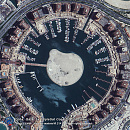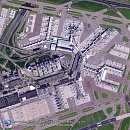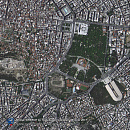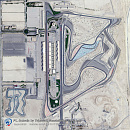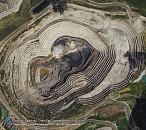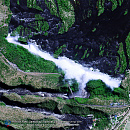Technical characteristics of satellites TripleSat Constellation-1, 2, 3
| Name of the spacecraft | DMC-3 (TripleSat) |
|---|---|
| Country | China |
| Developer | SSTL |
| Operator | 21AT |
| Launch date | 10.07.2015 |
| Launch vehicle | PSLV-28 |
| Launching pad | Sriharikota (India) |
| Means of excretion | SSTL (United Kingdom) |
|
Orbit: height, km inclination, degree the crossing time of the equator, the hours |
Sun-synchronous 630 98.1 10:30 |
|
Platform: the angles of deflection, deg |
SSTL-300 S1 ±45º |
| Period of active existence, years | 7 |
| Follow-up period, day | 1 |
| Weight of each spacecraft, kg | 447 |
In the basis of the DMC-3 satellites is the 450 kg SSTL-300S1 series platform, capable of not only rapid tilt up to 45 degrees, but also the ability to capture multiple territories from a single flyby in multiple viewing mode.
Technical characteristics of the shooting equipment
| Name of shooting equipment | VHRI-100 |
| Spectral ranges, microns |
VHRI-100 Panchromatic: 0.42-0.65 Blue: 0.44-0.51 Green: 0.51-0.59 Red: 0.60-0.67 Near IR 1: 0.76–0.91 |
| Terrain resolution (in Nadir) PAN, m | 1 |
| MS, m | 4 |
| Dynamic range, bit | 10 |
| Of swath width, km | 23 |
| Data transfer rate, Mbit/sec | 320 |
DMC-3 grouping data processing levels
| Processing | ||||
| Products | Radiometrically and sensor corrected | Georectified | Orthorectified | Pan-sharpened |
| Level 1A | + | Optional | ||
| Level 2A | + | + | Optional | |
| Level 3A | + | + | + | Optional |
| Ortho | + | + | + | Optional |
Level 1A – designed for users who want to use their own geometric processing. Images are transmitted with radiometric correction, but without geometric correction, with RPC coefficients for further processing. The attached metadata allows accuracy up to 23 m SE90 in Nadir, without regard to the influence of curvature of the terrain.
Level 2A – images are ready for orthorectification or using, supplemented with built-in geographic information. Radiometrically and geometrically corrected data are recalculated to the default map projection set by WGS84. No elevation models or ground reference points are required; instead, data obtained automatically from the satellite is used. The images are delivered finished machined to a CE90 accuracy of 23m in Nadir and oriented to the North.
Level 3A – images are aligned and strictly processed using all metadata of a territory. This layer uses Landsat-8 imagery together with the SRTM-90 elevation matrix to obtain sub-pixel accuracy of the data, adjusted for differences in terrain elevation.
Ortho – such as Level 3A, but the images are aligned and rigorously processed using your original data to ensure accurate alignment to match the other base layers of the project or map. The provider accepts a wide range of reference point and elevation model format data. The accuracy of georeferencing can reach sub-pixel, that is up to 50 cm CE90.
Shooting mode
Standard response scene/strip: standard image acquisition mode. Any angle from Nadir to 45 degrees can be obtained. Scenes can be produced individually or as a strip up to 175 scenes long.
Fast response scene / strip: Like the standard mode, however, satellite rotations to the desired angle are performed much faster.
Area 2x2: artificial zoom shooting mode allows you to capture two scenes in width and two scenes in length.
- mapping;
- monitoring of land using, forests, agriculture;
- monitoring of hydraulic structures and ecological state of the environment, urbanized areas, as well as territorial planning.
For preliminary calculation of the cost and selection of coverage on the territory you are interested in space images from satellites TripleSat Constellation-1, 2, 3 send the terms of reference or the coordinates of the site by e-mail: innoter@innoter.com we will be glad to answer your questions by phone: +7 (495) 245-04-24

